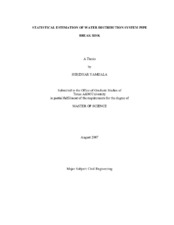| dc.description.abstract | The deterioration of pipes in urban water distribution systems is of concern to water
utilities throughout the world. This deterioration generally leads to pipe breaks and
leaks, which may result in reduction in the water-carrying capacity of the pipes from
tuberculation of interior walls of the pipe. Deterioration can also lead to contamination
of water in the distribution systems. Water utilities which are already facing tight
funding constraints incur large expenses in replacement and rehabilitation of water
mains, and hence it becomes critical to evaluate the current and future condition of the
system for making maintenance decisions. Quantitative estimates of the likelihood of
pipe breaks on individual pipe segments can facilitate inspection and maintenance
decisions. A number of statistical methods have been proposed for this estimation
problem. This thesis focuses on comparing these statistical models on the basis of short
time histories. The goals of this research are to estimate the likelihood of pipe breaks in
the future and to determine the parameters that most affect the likelihood of pipe breaks.
The various statistical models reviewed in this thesis are time linear and time
exponential ordinary least squares regression models, proportional hazards models
(PHM), and generalized linear models (GLM). The data set used for the analysis comes from a major U.S. city, and the data includes approximately 85,000 pipe segments with
nearly 2,500 breaks from 2000 through 2005. The covariates used in the analysis are
pipe diameter, length, material, year of installation, operating pressure, rainfall, land use,
soil type, soil corrosivity, soil moisture, and temperature. The Logistic Generalized
Linear Model fits can be used by water utilities to choose inspection regimes based on a
rigorous estimation of pipe breakage risk in their pipe network. | en |


